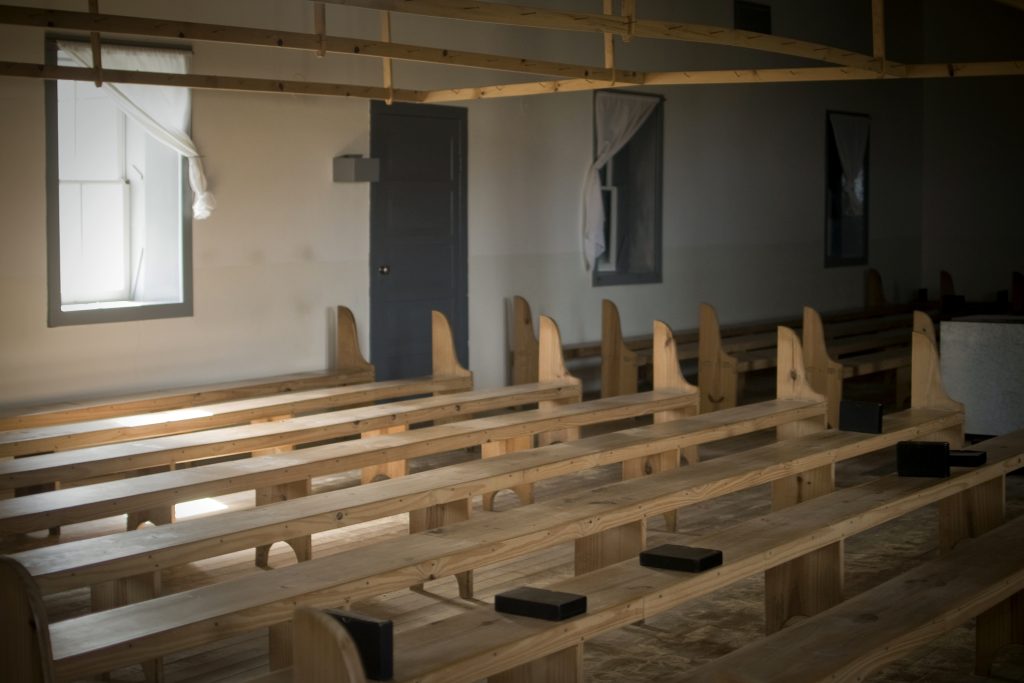nuCamp was established by Joe Mullet, who grew up in the Amish community in Sugarcreek, OH. The enduring values and traditions of the Amish have left an influential mark on nuCamp’s culture. Many of our production workers are Amish, and we are enthusiastic about sharing the rich history of Amish culture with our nuCamp family. In this series, titled “Our Amish Heritage,” Rebuen Shelter, a former nuCamp team member, shares a glimpse into the Amish way of life.
Ausbund, the Oldest Songbook
Songbooks are scattered on the benches. Thick books with black hard covers. They’re spaced a few feet apart, waiting. In a few minutes, men and women will walk through the doors of the shop building. The people will sit down, and hands will pick up the black books. Then the hardcovers will be opened, and the Amish church service will begin.
On the cover is the name of the book: “Ausbund.” This is a German word that means “select.” But inside the cover is a much longer title. The book’s full title is: “Selected Excerpts: that is, several beautiful Christian hymns by the Swiss Brethren as they lay in prison at Passau and by other true-believing Christians.”
This songbook is the oldest continuously used hymnal in the world. The Amish church is the only church that still uses it. The songs are sung in German in slow, mournful tunes. The songbook goes back to 1564, the tunes to the 1200-1300s.
The “Ausbund” has influenced the Amish church greatly with its hymns of suffering and sorrow. They speak of persecution, injustice, and death. But there is an underlying message of hope — of God redeeming His people.
So where does the “Ausbund” come from? What’s the story behind the oldest songbook in the world? Join me as we examine its history and travel along its journey to today.
The History of the Ausbund
In the summer of 1535, hundreds of Anabaptists were chased out of Moravia. They left their thriving farms behind and traveled toward the Rhine Valley in Germany. Here, they hoped to regroup with similar-believing people.
However, not all of them made it to the valley. Near Passau, authorities captured several groups of these fleeing Anabaptists. Fifty-three men were thrown into the dungeon at Oberhaus Castle.
The dungeon was dark and damp. It was not fit for human beings. They faced terrible living conditions. Often, they were summoned for brutal torture sessions. The authorities were determined to force these Anabaptists to give up their faith. But despite the cold, hunger, terror, and inhumanity, they did not give up their faith. Instead, they wrote songs.
The Anabaptists were kept in the dungeon for five long, miserable years — from 1535 to 1540. Not all of them survived the ordeal. But the words they wrote did and are still living today. Fifty-one hymns, known as the Passau Prison songs, were created in that horrible dungeon of filth. And this was the beginning of the “Ausbund.”
The prisoners put tunes to the words they created. These tunes were common folk songs of the day. The Amish sing these tunes slowly, in a lilting rhythm like a chant. Tradition has it that the prisoners sang the songs slowly, so the guards could not understand the words they were singing. The tunes are so slow it’s hard to comprehend the song’s meaning.
The printing of the Ausbund
Twenty-four years after the prisoners had been released, the first “Ausbund” was printed. It immediately became popular among the Anabaptists. They could identify with these songs of suffering written in the dungeon. There was a demand for the “Ausbund,” and it did not remain a secret for long.
The authorities discovered the book and how it was being used for worship. By 1692, the “Ausbund” had become illegal. The Swiss Canton of Bern forbade anyone from printing it. However, the “Ausbund” continued to be produced in secret. This is still evident today. Most early versions of the “Ausbund” have no publisher information in the book.
The second edition of the “Ausbund” was printed in 1583, in which 80 new songs were added to the original 51. Eventually, there were 11 different editions printed in Europe.
When the Anabaptists traveled to America, the “Ausbund” went with them. The first American printing was done in Germantown, Pennsylvania, in 1742, by a Mennonite bishop named Henry Funck. By now, the “Ausbund” had bloomed to 140 songs.
The Mennonites used the “Ausbund” until the early 1800s. Since then, only the Amish have continued to use it. The book has undergone sixty printings, with over 100,000 printed in America. Around 10,000 new books are being printed yearly so this number will grow substantially. And as each year passes, the age and legacy of the “Ausbund” continues to grow.
A Sacred Song
The most famous song in the “Ausbund” is “Das Loblied.” This song is especially sacred to the Amish. It is sung at every Amish church service and is always the second song. This means that this beautiful tune of praise is being sung simultaneously at hundreds of Amish church services. It takes around 20 minutes to sing the “Loblied,” and often, it’s a time of deep reflection and worship. Anyone who has ever heard the poignant tune will never forget it.
Leenavert Clock wrote “Das Loblied” in 1625 in Holland. Other composers of “Ausbund” songs are Anabaptist legends — Michael Sattler and Hans Betz, who were tortured, and George Blaurock, the first to be re-baptized. The leader of the Passau prison group, Michael Schieder, wrote 11 of the songs.
Song 100 is unique because all fourteen verses were written by different people. Their initials are noted at the beginning of the verses. This song is one of the originals from the dungeon. Imagine the sense of brotherhood, the spirit of unity, and the love between these men as they took turns adding their personal touch to a song of sorrow, a song of hope. Indeed, the first line translates to “with joy will we sing.”
The songbooks of today have red sprinkles along the edge of the paper, a sacrament to the blood shed by these early fathers of faith. In America, the Amish no longer have to worry about persecution. But the memories remain, many of them preserved in the black songbook.
“Dicke Buch”
The books are transported from one church service to another in a wagon with the benches and other church supplies. This wagon is called the “bench wagon.” But most Amish homes have an “Ausbund” on the bookshelf as well. It’s affectionately called the “Dicke Buch,” which means “thick book.” And rightfully so. The one sitting on my desk as I write has 895 pages.
There is only one “Ausbund” left from the original printing. It is preserved in the Mennonite Historical Library at Goshen College. I’d like to see it someday.
But for now, I’ll just be satisfied with holding a copy during our Amish church services. I’ll hold the book with reverence and respect. I’ll hold it and contemplate the profound journey it represents. I’ll remember our forefathers, who were captured and thrown into that dungeon. Despite their hardship, they found solace and peace in writing these songs amidst the pain they experienced. I’ll celebrate the triumph of the first printing and acknowledge the times when it faced prohibition. Meanwhile, I will marvel at how it persevered, endured, grew, and bloomed into what it is now. I’ll reflect on it all, and I’ll appreciate and cherish it for what it is: the oldest continuously used songbook in the world.
Recent Articles





